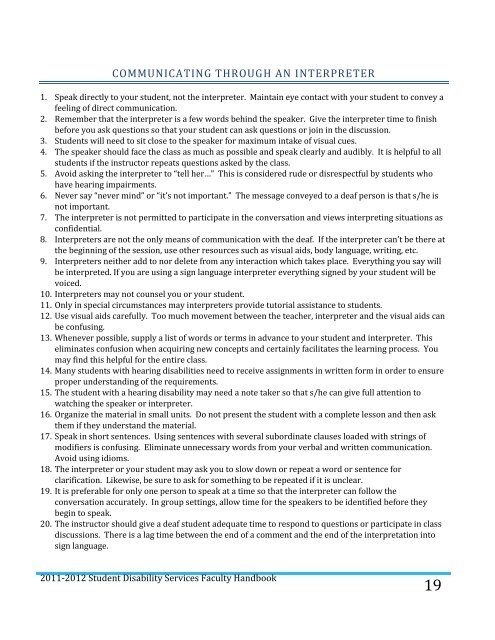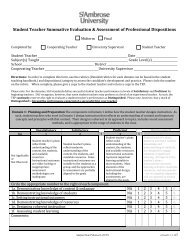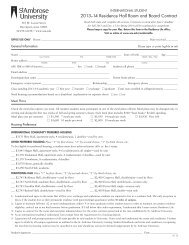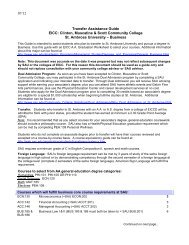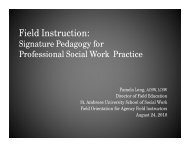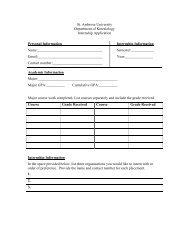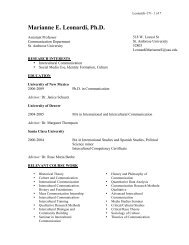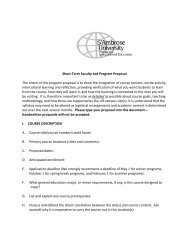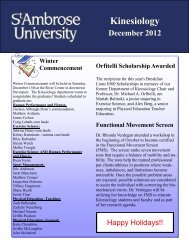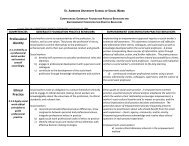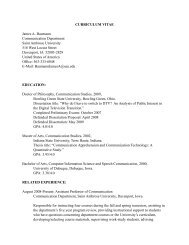student disability services faculty handbook - St. Ambrose University
student disability services faculty handbook - St. Ambrose University
student disability services faculty handbook - St. Ambrose University
You also want an ePaper? Increase the reach of your titles
YUMPU automatically turns print PDFs into web optimized ePapers that Google loves.
COMMUNICATING THROUGH AN INTERPRETER<br />
1. Speak directly to your <strong>student</strong>, not the interpreter. Maintain eye contact with your <strong>student</strong> to convey a<br />
feeling of direct communication.<br />
2. Remember that the interpreter is a few words behind the speaker. Give the interpreter time to finish<br />
before you ask questions so that your <strong>student</strong> can ask questions or join in the discussion.<br />
3. <strong>St</strong>udents will need to sit close to the speaker for maximum intake of visual cues.<br />
4. The speaker should face the class as much as possible and speak clearly and audibly. It is helpful to all<br />
<strong>student</strong>s if the instructor repeats questions asked by the class.<br />
5. Avoid asking the interpreter to “tell her…” This is considered rude or disrespectful by <strong>student</strong>s who<br />
have hearing impairments.<br />
6. Never say “never mind” or “it’s not important.” The message conveyed to a deaf person is that s/he is<br />
not important.<br />
7. The interpreter is not permitted to participate in the conversation and views interpreting situations as<br />
confidential.<br />
8. Interpreters are not the only means of communication with the deaf. If the interpreter can’t be there at<br />
the beginning of the session, use other resources such as visual aids, body language, writing, etc.<br />
9. Interpreters neither add to nor delete from any interaction which takes place. Everything you say will<br />
be interpreted. If you are using a sign language interpreter everything signed by your <strong>student</strong> will be<br />
voiced.<br />
10. Interpreters may not counsel you or your <strong>student</strong>.<br />
11. Only in special circumstances may interpreters provide tutorial assistance to <strong>student</strong>s.<br />
12. Use visual aids carefully. Too much movement between the teacher, interpreter and the visual aids can<br />
be confusing.<br />
13. Whenever possible, supply a list of words or terms in advance to your <strong>student</strong> and interpreter. This<br />
eliminates confusion when acquiring new concepts and certainly facilitates the learning process. You<br />
may find this helpful for the entire class.<br />
14. Many <strong>student</strong>s with hearing disabilities need to receive assignments in written form in order to ensure<br />
proper understanding of the requirements.<br />
15. The <strong>student</strong> with a hearing <strong>disability</strong> may need a note taker so that s/he can give full attention to<br />
watching the speaker or interpreter.<br />
16. Organize the material in small units. Do not present the <strong>student</strong> with a complete lesson and then ask<br />
them if they understand the material.<br />
17. Speak in short sentences. Using sentences with several subordinate clauses loaded with strings of<br />
modifiers is confusing. Eliminate unnecessary words from your verbal and written communication.<br />
Avoid using idioms.<br />
18. The interpreter or your <strong>student</strong> may ask you to slow down or repeat a word or sentence for<br />
clarification. Likewise, be sure to ask for something to be repeated if it is unclear.<br />
19. It is preferable for only one person to speak at a time so that the interpreter can follow the<br />
conversation accurately. In group settings, allow time for the speakers to be identified before they<br />
begin to speak.<br />
20. The instructor should give a deaf <strong>student</strong> adequate time to respond to questions or participate in class<br />
discussions. There is a lag time between the end of a comment and the end of the interpretation into<br />
sign language.<br />
2011-2012 <strong>St</strong>udent Disability Services Faculty Handbook<br />
19


